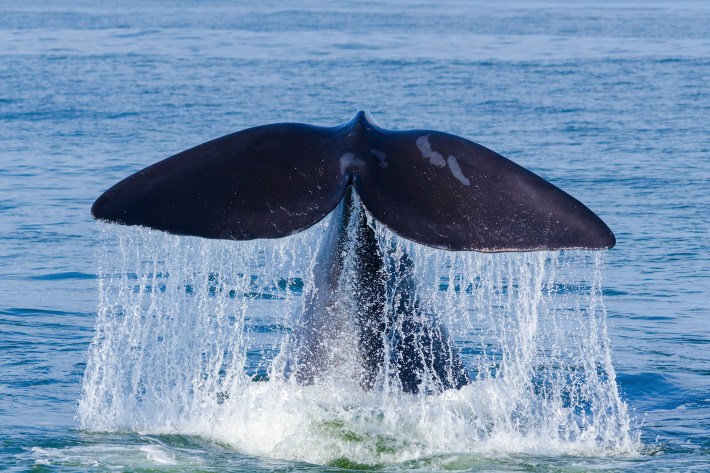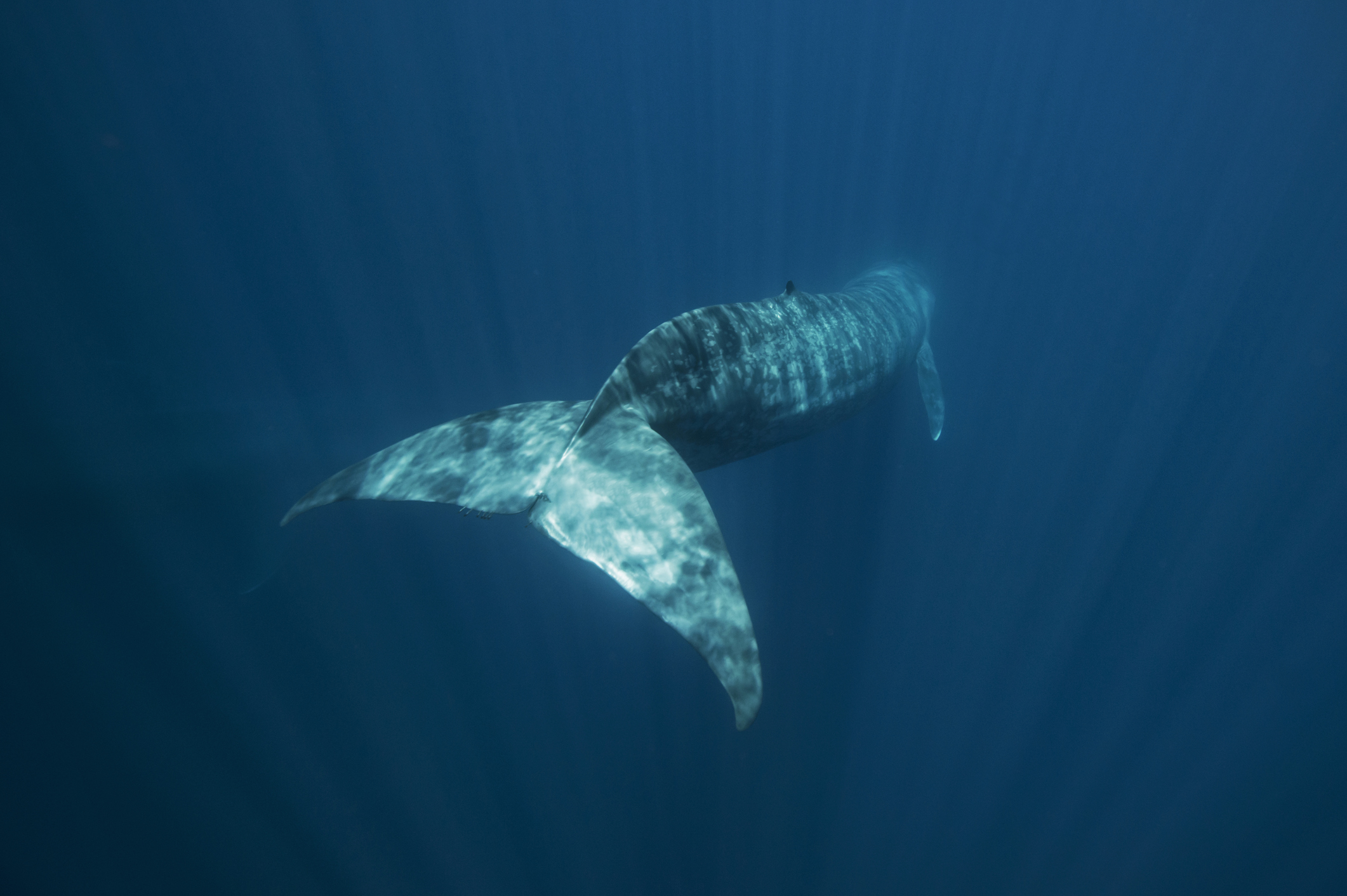Blue whales are not just the largest animals alive today, but the largest animals to ever live on Earth. They can stretch past 100 feet long and weigh up to 330,000 pounds. Being this big, it seems, should render blue whales impervious to predators. But just as no bank is too big to fail, no whale is too big to totally evade being eaten by the ocean's top predator. Killer whales prey on nearly every large animal species found in the ocean, and blue whales are no exception.
In 2022, scientists confirmed that a pod of orcas can take down an adult blue whale, not to mention the smaller calves they frequently hunt. "Killer whale attacks on large whales is the biggest predation event that occurs on the planet," Robert Pitman, a researcher with the Marine Mammal Institute at Oregon State University, wrote in an email. "There probably hasn’t been anything on that scale since dinosaurs roamed the earth."
Orcas pose a threat to all species of baleen whales, which are famously known to sing. These songs could endanger the whales, alerting the orcas to the whales' presence. But a new paper in the journal Marine Mammal Science suggests that blue and other big baleen whales are capable of a phenomenon dubbed "acoustic crypsis"; that is, they sing at frequencies or levels too low to be detected by killer whales.
The idea first came to Trevor Branch, the sole author of the new paper and a scientist at the University of Washington, when he was on sabbatical last year. He was trying to write a book about blue whales, which involved reading everything that has been written about them. One book he picked up mentioned the lower hearing limit of orcas. "It suddenly struck me that they couldn't hear blue whales at all," Branch said. "And I thought, wait, that can't be right. That's just impossible." He started poking around in the literature and found evidence suggesting that killer whales cannot hear sounds below 100 Hz. (Of course, Branch caveated, orcas' hearing abilities are as variable as those of humans; "some can hear much better than others, and some of them have hearing loss.")
Branch came up with a hypothesis: If killer whales can't hear blue whales, maybe the hunters couldn't hear any other species of baleen whale. But as he tracked down the calling frequencies of other species, he learned that killer whales could actually hear some species, disproving his hypothesis. "It was like a constant series of revelations," Branch said. "Getting my theory dashed, and then coming up with a new theory and getting that dashed," he said. But then Branch realized the two groups of whales he had discovered—the whales orcas could hear and the whales orcas couldn't hear—mapped onto another theory he'd encountered.
The fight or flight theory, proposed in a 2008 paper, divided baleen whales into two discrete categories of defense against orcas. The "fight" whales—which include right whales, bowhead whales, grey whales, and humpbacks—actively defend themselves and their calves against killer whale attacks. "I read a case of a right whale smacking an orca straight out of the water 20 feet up in the air," Branch said. Conversely, the "flight" group—which includes blue whales, minke whales, Bryde's whales, sei whales, and fin whales—flee in response to killer whales, often reaching speeds of 24 miles per hour for hours at a time.

In Branch's research, he generally found the killer whales could hear the higher-frequency songs of the fight whales, but not the lower-frequency songs of the flight whales, allowing the latter, defenseless group to communicate, undetected, in the vast open ocean. And it wasn't just the frequency, but also the levels, at which the whales were calling; flight species often did not call as loudly or as frequently as fight species. For example, minke whales—whose tongues are a prized orca treat—rarely ever call. "They just wander around silently," Branch said. "They're like submarines."
For a long time, scientists disputed how common and significant a threat orcas posed to baleen whales, said Peter Corkeran, a marine ecologist and conservation biologist at Griffith University in Brisbane, Australia, who reviewed the new paper. "No one saw a lot of orca attacks back then, because there weren't that many whales around," Corkeran said. In 1999, Corkeran and a researcher named Richard Connor published a paper, "Why Do Baleen Whales Migrate?", which argued that orca predation had a bigger influence on baleen whales than was previously believed. The researchers hypothesized that the baleen whales' annual migrations allowed mothers to birth and raise calves in areas with reduced risk of killer whale attacks. "People just thought we were insane," Corkeran said. "Now it's accepted."
Pitman saw his first killer whale attack in 1997, when a pod of 35 orcas attacked a pod of nine sperm whales. During these attacks, sperm whales, a fight species, arrange themselves in a rosette, their heads pointing to the center and tails pointing outward, ready to slap an orca away. Pitman and colleagues watched as the orcas circled and lunged toward the rosette of sperm whales until they could isolate one whale and deal a fatal blow. Pitman found the attack so moving that he spent the next 20 years studying killer whales. "It is hard not to be enthralled," he said.
Different populations of killer whales prefer different prey. But orcas that hunt marine mammals find their prey acoustically, said Pitman, who was not involved in the new paper. "But they have limitations on their ability to detect sounds, and their prey take advantage of that," he said. He said he wasn't too surprised by the findings of the new paper, as scientists have known that smaller whales produce higher-frequency songs above an orca's hearing range. Pitman added that the loud, low-frequency calls of large whales offer the animals another benefit of being able to communicate across many hundreds of miles.
In the new paper, Branch speculates whether the threat of orca attacks has shaped other aspects of baleen whale evolution, such as the shifts in their songs. A blue whale has a simple, monotonous song that does not evolve year after year, unlike the complex songs of bowheads and humpbacks. "Blue whales are like 'wah-wah,' 'wah-wah,' 'wah-wah,' for hours and hours and hours," Branch said. A 2009 paper identified a mysterious trend: all populations of blue whales worldwide have gradually deepened their songs since the 1960s. Branch wonders if killer whales might be behind the deepening songs; perhaps the lowest-singing blue whales were more likely to evade predation and produce more offspring. He also wonders if orcas explain the rapid growth of blue whale calves, which are born 23 feet long and grow to about 52 feet in just seven months—a size that makes them far more difficult prey.
Branch sees this paper as a concept: a very simplistic analysis of an idea he thinks works, that he hopes others will test in experiments. For him, the research was a labor of love—a project undertaken with no funding‚ although he's since applied for a grant from the National Science Foundation to continue the research. Last month, the NSF froze payments to all existing grants in response to Trump's orders targeting DEI efforts. "I'm hoping there will still be an NSF to fund us, of course," Branch said.






